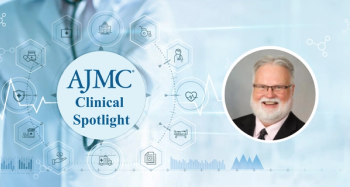
New Treatments for Newly Diagnosed MM Offer a Lot of Benefit, but Key Knowledge Gaps Remain
While there is, rightfully, a lot of optimism around the latest treatments for newly diagnosed multiple myeloma, not everyone is gaining the same benefit, said Kenneth Shain, MD, PhD, of H. Lee Moffitt Cancer Center.
The data around new treatments for newly diagnosed multiple myeloma shows patients are getting great benefits, but longer-term data is still needed to fill in some of the knowledge gaps, said Kenneth Shain, MD, PhD, associate member of the Departments of Malignant Hematology and Chemical Biology and Molecular Medicine, and codirector of the Pentecost Myeloma Research Center, H. Lee Moffitt Cancer Center.
In an interview with The American Journal of Managed Care® (AJMC®), Shain also discussed the patients who aren’t gaining the same benefits, such as high-risk patients.
In
AJMC: How are you incorporating recent pivotal trials findings around CD38 antibodies into upfront treatment decisions for transplant-eligible populations?
Shain: Everything we've talked about for the transplant-ineligible and transplant-eligible patients is dictated by the fact that these CD38 monoclonal antibodies are highly effective and carry less toxicity. The efficacy and the safety of these products are really so attractive. They're changing how we take care of our patients. We now have deeper responses. We have longer, better outcomes. We've gone from 2- to 3-drug therapies and then 3- to 4-drug therapies based on just these data. We're learning that we are gaining depth of response. We're gaining control of disease. There remain some unknowns. Is this going to affect what happens later on? We don't know yet. I practice where I don't know what a patient is going to get next, and I want to give them the best I can upfront and get the deepest response I can upfront, because that's the longest lasting response we're going to get.
I think without question,
AJMC: What are some of the key knowledge gaps that do still remain in defining optimal CD38 antibody sequencing strategies?
Shain: One is defining optimal CD38 antibody therapy. The gaps are: (1) is there one better than the other, which we may never know the answer to, and (2) how is this going to affect later therapy? So, just like the monoclonal antibodies have made huge changes in how we're taking care of induction of newly diagnosed patients today, they've already had this kind of real nice effect on patients who've had relapsed disease. You have to remember that newly diagnosed patients are just beginning their journey. These patients are going to have 3, 4, 5, 7, 9, 20 relapses and 20 different lines of therapy. We have to really think about what we're doing and how we sequence it.
I think we have to learn more about how this is affecting the next line of therapy. Those are kind of things we'll have to learn as we get through things. For all the gains we're making, are we losing them later on? Those are questions that we don't know the answer to today, because it's still early in their utilization. The hope and anticipation is that by maximizing and reducing the number of drugs used long term, you're going to still maintain those gains. But we just don't know that answer today.
I think this is a true statement about anything we do in myeloma: every patient is an individual. Some patients don't need 4 drugs or 3 drugs, and they'll do just as well. We're just not that smart yet to figure out who are those patients and who aren't those patients. But I think those are the real things that I think we need to figure out. Who are those patients? Are there risk factors? Are there cytogenetic risk factors or molecular risk factors that tell us one might work better than the other? Who doesn't gain the benefits you see versus the toxicities? Those are some of the major knowledge gaps we have.
But positively, these therapies are adding a lot of efficacy and control of disease. But whether they're necessary all at once or can you use them in maintenance? These are questions that are out there because of studies that have been done suggesting that maybe you see a CD38 monoclonal antibody at some point in that first line of therapy, either with maintenance or with induction. Do you have to add them all together? These are things that we don't know. But I think the way the studies have been designed and the data they have really suggests we start with them and may drop them off as we go along through the sequence of therapy.
AJMC: What factors around administration, logistics, and supportive care requirements do you consider when assessing novel monoclonal antibody combination regimens for transplant-eligible patients?
Shain: When daratumumab was first approved, it was approved as an intravenous (IV) drug that took 8 hours to give the first dose. People had to wait around forever, and they had infusion reactions. Then the next dose was 4 hours. And then we could do it in 90 minutes, which was super fast. But in the end, it's not that fast for patients who want to live their life. Seeing us does not equate to quality of life for patients with myeloma. So how do we minimize time in a chair away from their family and friends and life?
The development of subcutaneous administration of daratumumab really changed its utilization, and how we think about it. Now it's a 5-minute injection. It's a lot safer than it used to be—from 40% or 50% infusion reactions the first day to only 10% to 14% administration reactions the first day and only 5 minutes in the chair. It's a really attractive therapy just from that first dosing perspective. We know it's safer along the way, except some patients can have administration reactions that they really can't handle. But it's very rare. Also, the dosing is spread out. So, it's weekly for 2 cycles. Then it's every other week for 4 more cycles. Then it becomes once a month, every 4 weeks. Again, it’s very attractive to patients who don't want to hang out with us all the time.
At a really high level that's one of the biggest disparities between the 2 monoclonal antibodies. Isatuximab remains an IV drug. It is a weekly dose initially. Then it goes to every other week. It's not like it's a huge difference, but it's still a difference. And patients get more time in the chair. We don't have the data spreading it out to every 4 weeks for patients. Some patients might just pick a therapy because of the small difference between the 2 options. They think: “I'd rather be there once a month versus having it twice a month.”
I think pre–medication-wise, it's not that dissimilar between the 2 infusion reactions. Risks are different because subcutaneous is safer. It's really the first dose you have issues with. The second dose, a little less. And after that, there aren’t many risks for either of these therapies. The first couple of administrations are the ones that you’re worried about these infusion reactions or administration reactions.
The question we all have is: will there be data that would suggest one is that much better than the other? You really can't compare across trials and they've never been tested head-to-head. So, we may not know, but those are definitely pieces of information that patients want to know, because they want to know what's a little better for them or not. I think that they're both incredibly solid therapies. I don't see them as being hugely different in terms of efficacy. They're both great. It's just how do you want to judge that? And how does your patient want to utilize these therapies?
AJMC: What are remaining unmet needs or challenges you see around optimizing frontline therapy for transplant-eligible myeloma?
Shain: The reality for us is that we've come a long way in the world of myeloma where patients should have really nice expectations in terms of their outcome, but it's still dictated a lot by risk. There are still patients who have high-risk disease, whether we know it up front because of their molecular characterization and their laboratory findings, or they don't know because their disease doesn't respond the way we expect and we find out later on that they're high-risk when they don't do as well. We're still not taking care of everybody equally. There's a lot of heterogeneity in response and outcomes. I think everybody's improving, but who we call standard-risk patients are doing better than our high-risk patients. That's a real unmet need: how do we take care of these high-risk patients better?
That leads into the next comment: we never talk about curing anyone. Myeloma is an all but incurable but very controllable disease today, but patients would much rather hear that they're going to be off therapy or have controlled disease for a long time or actually not have to worry about coming back in the future. Those are things that we still have and will always struggle with and I see us struggling with for a long time. But we're at a point now where we might have the tools. We have some really good 4-drug therapies. We have high-dose therapy with transplant. We have maintenance therapy. But we have hints of people who might be able to stop therapy. We talked about the
What's really exciting beyond even the monoclonal antibodies we're talking about now and how they have affected newly diagnosed treatment is there's another generation behind us with immunotherapies. Some monoclonal antibodies are immunotherapies. The CD38s directly kill myeloma cells, but also recruit other parts of the tumor microenvironment immune system to come help destroy myeloma cells. But now we have T-cell engagers and chimeric antigen receptor T-cell therapies on the horizon. How can we use them in earlier and earlier lines of therapy? How will that change and help us take care of these high-risk groups or folks who really aren't benefiting as much as everybody else is?
I think the future continues to be very bright. I think we're in a nice transition. But one of the things I kind of try to tell patients when I meet them the first time is myeloma is about hope and reality. When you first meet you, you don't like having myeloma, no one does. But there is really a lot of hope, because we have so much we can do today. In the history of time, this is the best time to ever have myeloma. Tomorrow is going to be even better. Those are the things we have to keep in mind: We’re light years away from where we were when I started practicing and my mentors started practicing and hopefully we will be that much further along in the next decade or 2 decades as we go.
The hurdles are still there. We have to get better at identifying high-risk patients. We aren’t curing people. We need to better personalize therapy. But I think we have tools that really might help us overcome some of these things. There's a lot of optimism.
AJMC: Is there anything else you want to add?
Shain: The growing treatment paradigm is that we want to use the drugs we have with different mechanisms up front to ensure we're getting a better depth of response and controlling the multiple clones that exist within myeloma at a given time. This is a major point of what we're trying to do today. Using new technologies to help us figure out what to do, such as minimal residual disease testing, whether it be by multiparameter flow, next-generation flow, or next-generation sequencing, are things that we need to really push forward in the community to help guide patient care and tell us how well we are or aren’t doing. It's slow to be picked up in the community, but I think these are things that really will help us make better decisions for our patients in the long run.
While there is a lot of optimism around where we are and where we're going, we can't forget that not everybody is gaining the same benefit. We can't forget that, and we have to make sure we're still pushing to really identify therapies or sequences of therapies that help these high-risk patients who haven't benefited quite as much as everybody else.
References
1.Sonneveld P, Dimopoulos MA, Boccadoro M, et al; PERSEUS Trial Investigators. Daratumumab, bortezomib, lenalidomide, and dexamethasone for multiple myeloma. N Engl J Med. 2024;390(4):301-313. doi:10.1056/NEJMoa2312054
2. Gay F, Roeloffzen W, Dimopoulos MA, et al. Results of the phase III randomized Iskia trial: isatuximab-carfilzomib-lenalidomide-dexamethasone vs carfilzomib-lenalidomide-dexamethasone as pre-transplant induction and post-transplant consolidation in newly diagnosed multiple myeloma patients. Blood. 2023;142:(Supp 1):4. doi:10.1182/blood-2023-177546
3. Costa LJ, Chhabra S, Medvedova E, et al. Minimal residual disease response-adapted therapy in newly diagnosed multiple myeloma (MASTER): final report of the multicentre, single-arm, phase 2 trial. Lancet Haematol. 2023;10(11):e890-e901. doi:10.1016/S2352-3026(23)00236-3
Newsletter
Stay ahead of policy, cost, and value—subscribe to AJMC for expert insights at the intersection of clinical care and health economics.





































